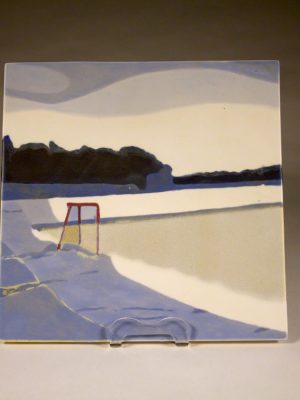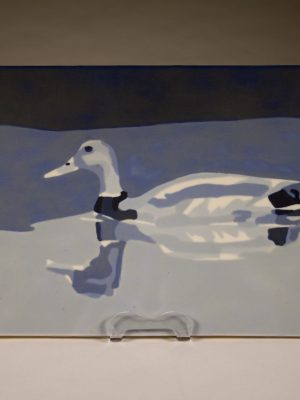I am taking this month off from the studio to work on the house and other projects. The posts this month will look at and discuss some of the work I have been finding as I organize the house.
I had thought these two tiles were long gone until I opened the box they were in. I was glad to see them again. I’ve always felt the tiles were some of my best work. Here’s a little of the story and process behind them.
One winter I was walking a frozen path along the Assiniboine River (Winnipeg) with my camera. I happened on private family’s hockey rink carefully maintained on the river below their home. The smooth ice set against the beautiful surroundings had a certain emotional impact, stirring up childhood memories. I am sure many adults who grew up here could relate.
The blue and white mallard is based on one I photographed while walking at Sturgeon Creek in the summer of 2010. It is one of several bird tiles I made at the time. My motivation was the Deep Water Horizon disaster in the Gulf of Mexico. I was horrified to think what these beautiful creatures would be returning to. For all I knew they would be migrating to their death. You probably wouldn’t get that to look at the tiles but that is what was in my head.
The images were processed in photoshop where I would do an over drawing to reduce them down to their basic elements. These elements were interpreted according to their grey scale value, a concept from colour theory where the shades of each colour are evenly stepped. Once the drawing was ready, it was printed to scale. It was then traced onto contact paper, cut it out with a swivel knife and rebuilt onto the surface of the tile. The contact paper drawing, essentially a single use stencil, was progressively removed as the glazes were filled in.
To make the grey scale seen in these tiles, I started by mixing the glaze both as ‘light’ (no stain) and ‘dark’ (1% stain). The ratio of light to dark for the steps of the scale is: 0:1,1:1, 3:1, 7:1, 15:1, 31:1, 63:1. Sometimes I add an extra step on each end. With the water content consistent in both light and dark, it’s just a matter of putting a container on the digital scale and adding the appropriate amounts for the step.


